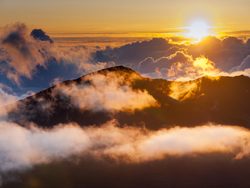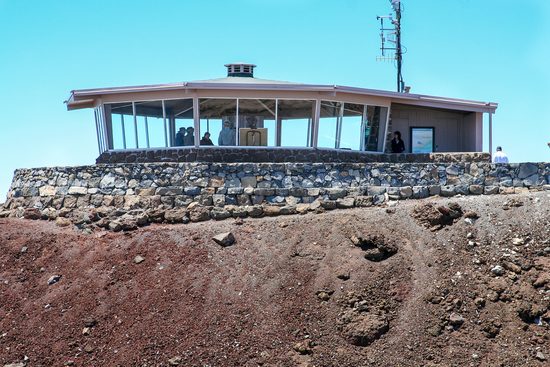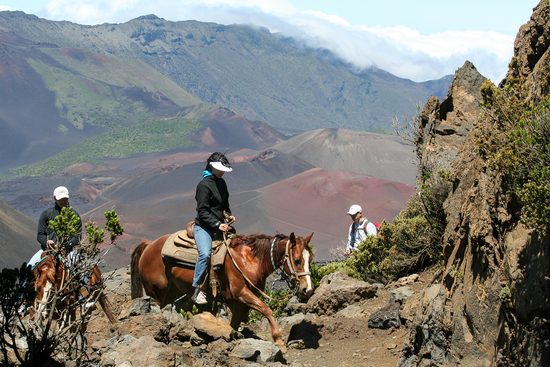
Haleakala National Park
Quick Navigation
Haleakala National Park is located on the southeast side of the island of Maui in Hawaii, United States. The park covers an area of 52 square miles (135.6 sq km), of which approximately two-thirds of that is classified as a wilderness area. Hawaii Volcanoes National Park on the "Big Island" is the only other national park in Hawaii.
The park features two separate sections which include the Haleakala summit area and the coastal Kipahulu area. They are accessed separately and are not connected.
Haleakala is a dormant volcano that is responsible for the creation of the island of Maui. The name of the mountain and park are from the Hawaiian word Haleakala, which translates “house of the sun.”
The Haleakala Crater has become more of an eroded valley, however, like a crater, it is 6.99 miles (11.25km) long, 2.0 miles (3.2 km) wide, and reaches a depth of 2,600 feet (790 m). Cinder cones can be found within the crater area.
A long scenic drive gives easy access to the summit along with views of the area along the way or as you return back down since the trip up was more than likely in the dark going up. If you are driving and not part of an excursion, make sure you leave about 30 minutes early than whatever time they tell you to leave by. The journey up can become quite a traffic jam. Early up also lets you get better seating in the hut if desired.
One of the fun excursions to participate in is to take a group trip up in vans while towing bicycles. You watch the sunrise and then ride bikes down the mountain. For all practical purposes, you will only coast down with little to no pedaling.
Kipahulu is accessed from a second separate from the summit drive that travels along the coastline. As part of the Kipahulu Valley, this area protects the rainforest and endemic species. It is recognized as the Kipahulu Valley Biological Reserve. There are over 24 pools that contain native freshwater fish.
The national park is home to more endangered species than in any other national park in the United States, however, the majority of these are not typical wildlife. The only native reptiles are sea turtles and the only native mammals are whales and the seal.
Highlights
The sunrise viewed from atop Haleakala is one of the most breathtaking and striking sunrises possible. Rising up early in the morning well before the sun rises, visitors will make their way to the summit where an observation area provides a place to watch the sun magically rise from the horizon.
Haleakala
 Haleakala reaches a summit of 10,023 feet (3,055 m) and is the highest point in Hawaii. It has another 19,680 feet (5,998 m) below the water which makes it collectively taller than Mount Kilimanjaro, Denali, and Mount Everest.
Haleakala reaches a summit of 10,023 feet (3,055 m) and is the highest point in Hawaii. It has another 19,680 feet (5,998 m) below the water which makes it collectively taller than Mount Kilimanjaro, Denali, and Mount Everest.
The highlight of Haleakala is the early morning drive to the summit to watch the glorious sunrise above the horizon. It is also a great place to explore the night sky and while stargazing into the deep richness of the dark sky.

Haleakala Sunrise Observation Deck
Travel to the top of Haleakala in the dark and grab your spot to watch one of the most glorious sunrises ever.

Horseback Riding
Haleakala is a mountain beckoning you to come explore and see all the views it affords to visitors. One of the best ways to experience the mountain and national park is on the back of a horse. Come discover Hawaii's Haleakala like a cowboy.
Haleakala National Park Trails
The national park has over 30 miles (48 km) of hiking trails making it easy for people to explore the coastal rainforest and the terrain of Haleakala.
Haleakala Highlights
- Haleakala
- Sunrise
Park Map
Sources
- All Trails, Best Trails in Haleakala National Park, https://www.alltrails.com/parks/hawaii/maui/haleakala-national-park, retrieved June 2020.
- Britannica, Haleakala, https://www.britannica.com/place/Haleakala, retrieved June 2020.
- Britannica, Haleakala National Park, https://www.britannica.com/place/Haleakala-National-Park, retrieved June 2020.
- Go Hawaii, Haleakala National Park, https://www.gohawaii.com/islands/maui/regions/upcountry-maui/haleakala-national-park, retrieved June 2020.
- Hawaii Guide, Haleakala National Park, https://www.hawaii-guide.com/maui/sights/haleakala_national_park, retrieved June 2020.
- Moon, Best Haleakala Hikes, https://www.moon.com/travel/national-parks/best-haleakala-hikes/, retrieved June 2020.
- National Geographic, Complete National Parks of the United States, National Geographic Publishing, Washington DC.
- National Geographic, Guide to the National Parks of the United States, National Geographic Society, 2003.
- National Geographic, National Parks of North America, Canada-United States-Mexico, National Geographic Society, 1995.
- National Park Service, Haleakala, https://www.nps.gov/hale/index.htm, retrieved June 2020.













